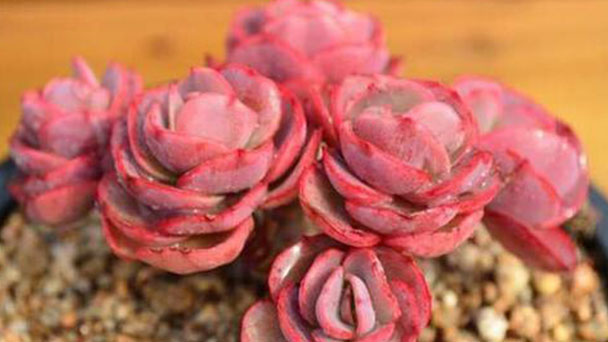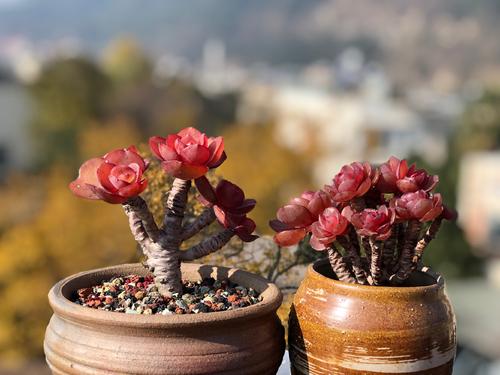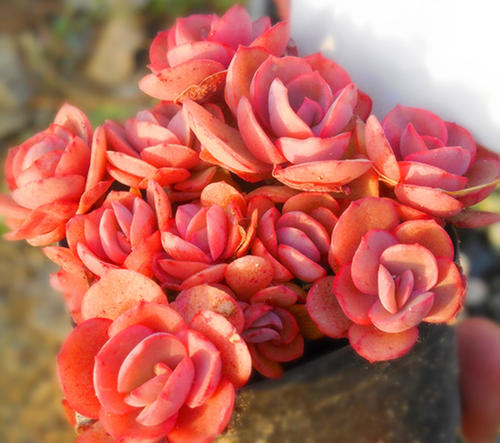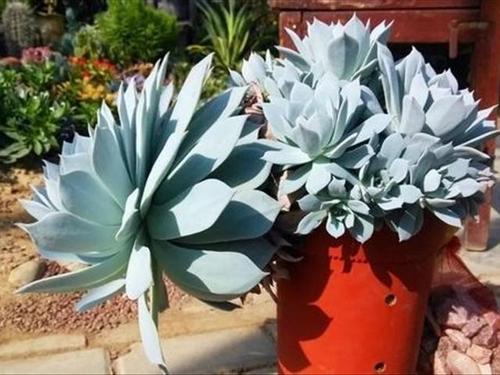How to Grow & Care for Echeveria Suyon
Written by Maggie
Dec 28 2022

Echeveria Suyon likes to grow under the sun. In the spring, autumn, and winter season, it needs to be put in a good light-curing clip for sun protection. Usually, loosen soil every 1 ~ 2 months, soil will be drenched, and thrive in a month and organic fertilizer rates.

How to Care for Echeveria Suyon
Get Plenty of Light for Echeveria 'Suyon’
The leaves of Echeveria 'Suyon' are red, which has a high ornamental value. In normal times, the leaves should be preserved in the light in spring, autumn and winter. When we grow Echeveria 'Suyon' in summer, the sun protection measures should be taken to give the leaves 4 hours of light in the morning and evening, so as to make the leaves bright red.
Loose Soil for Echeveria 'Suyon’
Echeveria 'Suyon' does not have high requirements on the soil, but it is best to loosen the soil every 1 ~ 2 months to avoid the effect of soil consolidation on the growth of plants. When we grow Echeveria 'Suyon', we also need to prepare loose soil, which can be mixed with red jade soil, coconut bran and small stones according to the ratio of 5:2:2.

Water & Fertilizer Management
In fact, Echeveria 'Suyon' has a particularly strong drought resistance, and we can generally water the soil thoroughly every 1 to 2 months. When we grow Echeveria 'Suyon', it does not need to be watered too often, and it does not need to be watered when the temperature is too low in winter. It does not have a high demand for nutrients, and organic fertilizer can be applied every other month.
How Do You Propagate Echeveria Suyon?
Echeveria suyon can be multiplied in many ways, but leaf propagation is the most straightforward. You can either gather freshly fallen leaves from your plant to use for this task or gently move a leaf's rosette from side to side until it separates.
Echeveria Suyon can be propagated easily by separating pups, but also by leaf cuttings, and by seed. For their foliage to develop color, they require a warm, sunny location with well-drained soil. Plants should ideally be placed in a partially shaded area.Echeveria Suyon should be placed on a tray away from direct sunlight once you have the leaves to propagate. At the end of the leaves, a plantlet with roots will emerge after a few weeks. Their roots can now be inserted into the ground, and every few days, you can mist them. The original leaves should eventually wither away, leaving behind the newly formed ones.
Potting and Repotting of Echeveria Suyon
1. Potting
Choosing the proper pot for your Echeveria is also essential to their care. Do not forget that larger pots hold more soil. Consequently, your echeveria suyon would be at risk of root rot since it would retain more moisture than smaller ones.
The size of your pot should ideally be 5 to 10% larger than the height of your Echeveria. Thus, if your Echeveria is 4 inches wide, the best pot for it will be one that is 4.5 inches in diameter or slightly larger than the rosette of your plant.
The type of pot that is most advised for Echeveria Suyon is one with good drainage. They have porous walls that will let extra moisture evaporate, keeping the plant from spending too much time in soggy soil. Furthermore, the echeveria roots will have something to cling to thanks to the unglazed interior of Terracotta pots.
2. Repotting
To give the succulent time to get used to its new home, repotting echeveria Suyon should be done just before the plant's growing season. Additionally, to give it room to grow, make sure your new pot is at least 10% bigger than your old one. Always keep an eye out for matted or rotting roots when repotting. If necessary, remove any damaged or decaying roots by pruning.
Will Echeveria Suyon Bloom?
Although Echeveria succulents are most well-known for their shape, they also have lovely, bell-shaped flowers that bloom for roughly two weeks during the growing season. These flowers, which are frequently pink or orange, beautifully offset the cool hues of the leaves. Place your succulent plants in warm, bright light to help them bloom. You'll be successful if you can mimic their natural surroundings. If you notice an Echeveria Suyon bloom emerging from your plant, there is no need to be alarmed. Simply cut the flower stem at the base with a pair of tidy, precise scissors to prevent your Echeveria from blooming.
What is the Toxicity of Echeveria Suyon
Along with being tough and adaptable, Echeveria Suyon are excellent for homes with pets, which is their best quality. Echeveria are a great starter succulent for anyone looking to add some green to their furry home because they are not toxic to cats, dogs, horses, livestock, or people. They don't necessarily want to be eaten, even if they aren't toxic. In order to maintain their happiness and health, it is always best to keep your succulents out of the way of curious animals.
Common Pests and Problems of Echeveria Suyon
Like any other succulent, Echeveria Suyon are prone to the usual assortment of pests and diseases, such as mealybugs, spider mites, root rot, aphids, scale, and mold. If watered incorrectly, these plants are particularly prone to developing mold and developing root rot. To be safe, always water your Echeveria from the bottom or with a water bottle, and avoid getting the leaves wet.
FAQs
Does Echeveria Need Direct Sunlight?
It is critical that you place your Echeveria Suyon in a window where it will receive a minimum of six hours of sunlight per day. Without continuous, direct light, your plant will start to sag and lose its attractive, compact shape.How Often Should Echeveria Be Watered?
The soil should be watered when it starts to become dry because Echeveria Suyon need regular watering from spring to fall. Winter water usage shouldn't be the same as summer usage. Watering the plant every one to two months should suffice.
Conclusion: How to Grow Echeveria 'Suyon’
When we grow Echeveria 'Suyon', the upper end of Echeveria 'Suyon' can be cut off in spring, and the wound of the leaf disk can be sprayed with polystyrene. When the wound of the leaf disk is dried, it can be buried by 1/3 with soil. The soil needs to be loosened, and it is not necessary to water and fertilize it when there is no rooting and explosion pot, but put it in the shade.
Echeveria Suyon cultivation and maintenance are straightforward! For more details, consult nurseries, a newsletter, or a guide from a dedicated website like ours with blogs written for echeveria plant care.

Read Next to Learn More About Caring for Other Echeveria Plants:
- Echeveria Elegans Mexican Snowballs Care & Growing Guide
- Echeveria Laui (Echeveria Succulent) Care Guide
- Echeveria Agavoides Care & Propagation
- Echeveria Pulvinata (Chenille Plant) Care & Propagation Guide
- Echeveria Nodulosa (Painted Echeveria) Care Guide
- Echeveria Imbricata (Blue Rose Echeveria) Grow & Care Guide
- Echeveria Setosa: Grow & Care for Mexican Firecracker
- Echeveria Black Prince Succulent Grow & Care Guide
- Echeveria Runyonii Topsy Turvy Grow & Care Guide
- Echeveria Takasago No Okina Care Guide
- Echeveria Mebina Care Guide
Latest Updated
- Benefits of Bugleweed - 7 Science-backed Health Benefits
- Bugleweed Dangers & Side Effects - Is It Poisonous?
- How to Plant Evergreen Trees - What You Should Know
- When to Plant Evergreens - Grow Guide for Evergreen Trees
- 12 Wonderful Evergreen Shrubs for Your Garden
- 12 Popular Evergreen Plants with Pictures for Beginners
- When And How To Prune A Lilac Bush Like a Pro
- How to Grow & Care for Lilac Vine (Hardenbergia Violacea)
- Japanese Lilac Tree (Syringa Reticulata) Care & Propagation Guide
- Shumard Oak Pros and Cons - What to Know
Popular Articles
- Winter maintenance of Antirrhinum Majus
- How to Grow Terminalia Mantaly Tree
- How to Grow and Care for Crossostephium Chinense
- How to grow Antirrhinum Majus in spring
- Peristeria Elata (Dove Orchid) Profile: Info & Care Guide
- Underwatered Snake Plant (Sansevieria Trifasciata) - Signs And How To Fix
- How to Care for Brazilian Jasmine Plant (Mandevilla Sanderi)
- How to Grow & Care for Graptopetalum Purple Delight in Summer
- Rosa Chinensis (China Rose): Plant Growing & Care Tips
- How to Care for Baby Sun Rose (Aptenia Cordifolia)